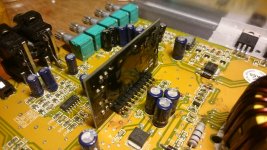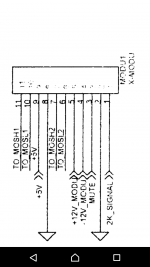I can not find the answer to my problem, the amp goes into protectmode but i cant find anything wrong with it.
I have replaced ALL of The transistors in The amp, nothing looks burned or smells.
Any ideas?
I have replaced ALL of The transistors in The amp, nothing looks burned or smells.
Any ideas?
The driverboard class D optocoupler can be defective (6N137), or some smd transistors. I have two SLA3000 defective here 😉
How do i check the optocouplers? What should the readings be?
What is this?;
"The amp has low voltage protection which could be triggered during power-up."
Is this something i can find and disconnect/solder out of the board that the amp would work without?
What is this?;
"The amp has low voltage protection which could be triggered during power-up."
Is this something i can find and disconnect/solder out of the board that the amp would work without?
What are you using to power the amp?
Was the problem in the vehicle precisely the same as you are seeing on the bench?
Do you have a scope?
Was the problem in the vehicle precisely the same as you are seeing on the bench?
Do you have a scope?
Im using a powersupply from a computer that puts out 12v/15Ah something.
Tought it might be powerproblem so i tested it in the car yesterday still the same problem.
The amp just went in to protectmode one day when cruising, had been playing for a few hours constantly.
What about that low power protectmode?
I have no scope.
Tought it might be powerproblem so i tested it in the car yesterday still the same problem.
The amp just went in to protectmode one day when cruising, had been playing for a few hours constantly.
What about that low power protectmode?
I have no scope.
It's low-voltage protection, not low-power protection.
The low voltage protection will engage when the voltage at the B+/ground is drawn too low. It's common for this to happen when a power supply with insufficient current capacity dips in voltage as the rail caps try to charge. When this happens, the amp will pulse on until the caps charge and the inrush current is low enough for the voltage to remain above the low-voltage threshold.
Besides normal inrush current, excessive current draw from some fault can cause the amp to draw the power supply voltage down and engage the low voltage protection.
There are, however, other protection circuits that can shut down the amp.
The low voltage protection will engage when the voltage at the B+/ground is drawn too low. It's common for this to happen when a power supply with insufficient current capacity dips in voltage as the rail caps try to charge. When this happens, the amp will pulse on until the caps charge and the inrush current is low enough for the voltage to remain above the low-voltage threshold.
Besides normal inrush current, excessive current draw from some fault can cause the amp to draw the power supply voltage down and engage the low voltage protection.
There are, however, other protection circuits that can shut down the amp.
Ok, was hoping i could fool the amp into starting.
I hate these kind of problems, its much more easy to fix something when its blown or burned so you can see whats boken..
Does somewone have a repairbook or something so i can mesaure everything in the amp?
I hate these kind of problems, its much more easy to fix something when its blown or burned so you can see whats boken..
Does somewone have a repairbook or something so i can mesaure everything in the amp?
When it tries to power up, do you see a spike of DC across the output terminals (if a speaker is connected, it would pop).
When it tries to power up, do you see a significant dip in the 12v at the B+ and ground terminals?
Schematic diagram:
http://www.bcae1.com/temp/SLA1500.pdf
When it tries to power up, do you see a significant dip in the 12v at the B+ and ground terminals?
Schematic diagram:
http://www.bcae1.com/temp/SLA1500.pdf
No and no.
I have 12v on 12(6pairs)of the transistors middle leg.
On a group of 8 others i have 2.2v
And on the r/s (2pairs) i have 1.2v
I have 12v on 12(6pairs)of the transistors middle leg.
On a group of 8 others i have 2.2v
And on the r/s (2pairs) i have 1.2v
I know some PC power supplies doesn't like inrush current like car audio amps have.
To test the power supply of the SLA1500 you can remove the rectifiers after the transformers. Than you can measure the railvoltage without load.
But if you have protection LED on, and the idle current draw is acceptable, I assume the power supply works ok.
To test the power supply of the SLA1500 you can remove the rectifiers after the transformers. Than you can measure the railvoltage without load.
But if you have protection LED on, and the idle current draw is acceptable, I assume the power supply works ok.
Its still 12v and the protectlight still on.
Do you know where the overheating-protection ting is?
What it looks like?
Feels like something like that is the problem.
I have a voltage reading pretty much everywhere i mesaure but i dont know what the values should be, so i dont know what to do?
Do you know where the overheating-protection ting is?
What it looks like?
Feels like something like that is the problem.
I have a voltage reading pretty much everywhere i mesaure but i dont know what the values should be, so i dont know what to do?
On the x-modu? I have 11,5v on the 3rd pin? There should be 5v or mute-pin so something wrong there, and no voltage on the other pins.
Inductor, not conductor.
There is only one inductor in the amp. The connection indicated by the green arrow appears to be burned.
There is only one inductor in the amp. The connection indicated by the green arrow appears to be burned.
- Home
- General Interest
- Car Audio
- SinusLive sl-a1500


